2010 GMC SIERRA DENALI belt
[x] Cancel search: beltPage 76 of 550
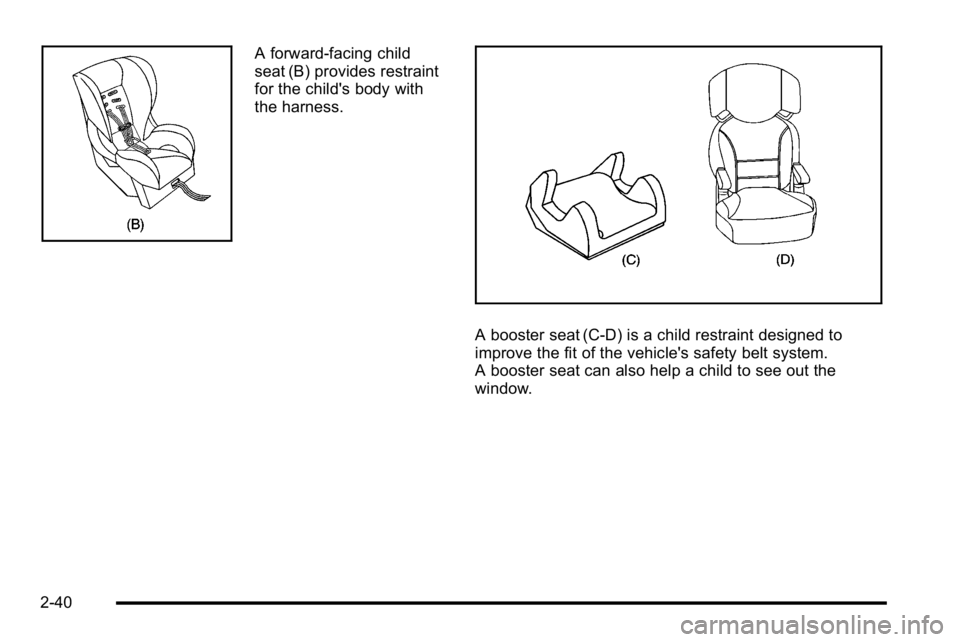
A forward-facing child
seat (B) provides restraint
for the child's body with
the harness.
A booster seat (C-D) is a child restraint designed to
improve the fit of the vehicle's safety belt system.
A booster seat can also help a child to see out the
window.
2-40
Page 77 of 550
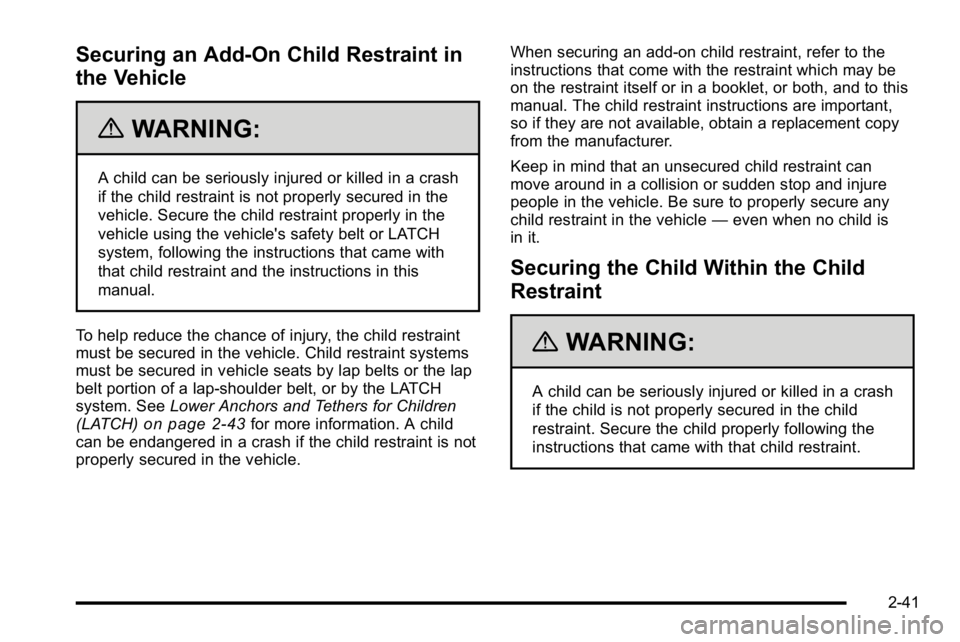
Securing an Add-On Child Restraint in
the Vehicle
{WARNING:
A child can be seriously injured or killed in a crash
if the child restraint is not properly secured in the
vehicle. Secure the child restraint properly in the
vehicle using the vehicle's safety belt or LATCH
system, following the instructions that came with
that child restraint and the instructions in this
manual.
To help reduce the chance of injury, the child restraint
must be secured in the vehicle. Child restraint systems
must be secured in vehicle seats by lap belts or the lap
belt portion of a lap-shoulder belt, or by the LATCH
system. See Lower Anchors and Tethers for Children
(LATCH)
on page 2‑43for more information. A child
can be endangered in a crash if the child restraint is not
properly secured in the vehicle. When securing an add-on child restraint, refer to the
instructions that come with the restraint which may be
on the restraint itself or in a booklet, or both, and to this
manual. The child restraint instructions are important,
so if they are not available, obtain a replacement copy
from the manufacturer.
Keep in mind that an unsecured child restraint can
move around in a collision or sudden stop and injure
people in the vehicle. Be sure to properly secure any
child restraint in the vehicle
—even when no child is
in it.
Securing the Child Within the Child
Restraint
{WARNING:
A child can be seriously injured or killed in a crash
if the child is not properly secured in the child
restraint. Secure the child properly following the
instructions that came with that child restraint.
2-41
Page 78 of 550
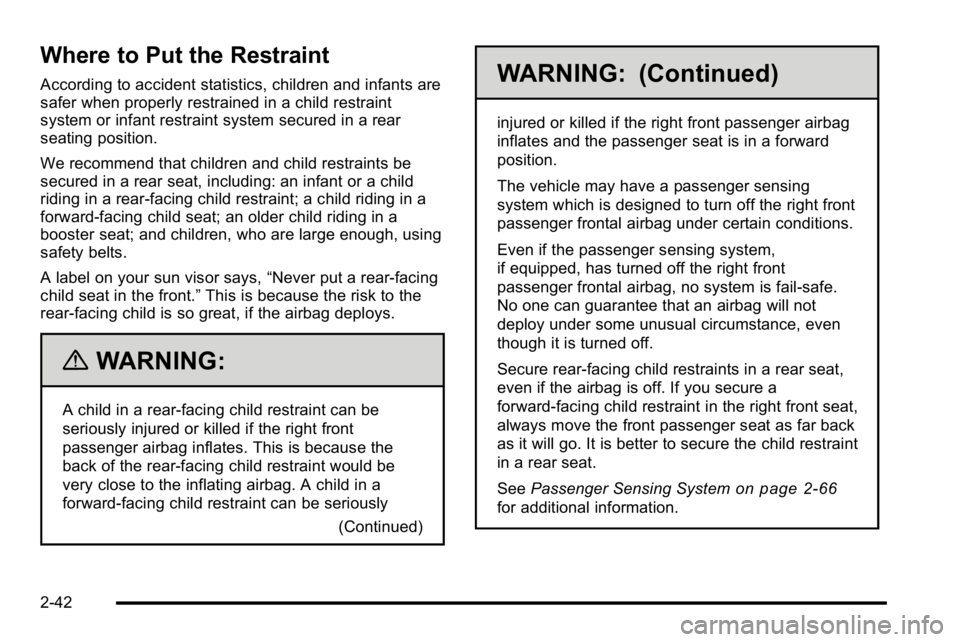
Where to Put the Restraint
According to accident statistics, children and infants are
safer when properly restrained in a child restraint
system or infant restraint system secured in a rear
seating position.
We recommend that children and child restraints be
secured in a rear seat, including: an infant or a child
riding in a rear-facing child restraint; a child riding in a
forward-facing child seat; an older child riding in a
booster seat; and children, who are large enough, using
safety belts.
A label on your sun visor says,“Never put a rear-facing
child seat in the front.” This is because the risk to the
rear-facing child is so great, if the airbag deploys.
{WARNING:
A child in a rear-facing child restraint can be
seriously injured or killed if the right front
passenger airbag inflates. This is because the
back of the rear-facing child restraint would be
very close to the inflating airbag. A child in a
forward-facing child restraint can be seriously
(Continued)
WARNING: (Continued)
injured or killed if the right front passenger airbag
inflates and the passenger seat is in a forward
position.
The vehicle may have a passenger sensing
system which is designed to turn off the right front
passenger frontal airbag under certain conditions.
Even if the passenger sensing system,
if equipped, has turned off the right front
passenger frontal airbag, no system is fail-safe.
No one can guarantee that an airbag will not
deploy under some unusual circumstance, even
though it is turned off.
Secure rear-facing child restraints in a rear seat,
even if the airbag is off. If you secure a
forward-facing child restraint in the right front seat,
always move the front passenger seat as far back
as it will go. It is better to secure the child restraint
in a rear seat.
SeePassenger Sensing System
on page 2‑66
for additional information.
2-42
Page 79 of 550
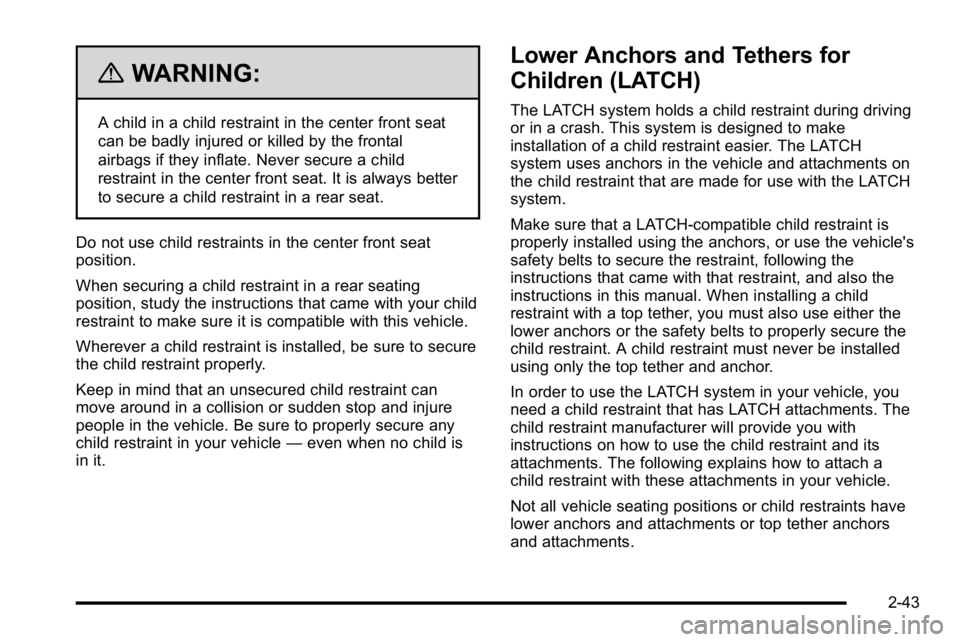
{WARNING:
A child in a child restraint in the center front seat
can be badly injured or killed by the frontal
airbags if they inflate. Never secure a child
restraint in the center front seat. It is always better
to secure a child restraint in a rear seat.
Do not use child restraints in the center front seat
position.
When securing a child restraint in a rear seating
position, study the instructions that came with your child
restraint to make sure it is compatible with this vehicle.
Wherever a child restraint is installed, be sure to secure
the child restraint properly.
Keep in mind that an unsecured child restraint can
move around in a collision or sudden stop and injure
people in the vehicle. Be sure to properly secure any
child restraint in your vehicle —even when no child is
in it.
Lower Anchors and Tethers for
Children (LATCH)
The LATCH system holds a child restraint during driving
or in a crash. This system is designed to make
installation of a child restraint easier. The LATCH
system uses anchors in the vehicle and attachments on
the child restraint that are made for use with the LATCH
system.
Make sure that a LATCH-compatible child restraint is
properly installed using the anchors, or use the vehicle's
safety belts to secure the restraint, following the
instructions that came with that restraint, and also the
instructions in this manual. When installing a child
restraint with a top tether, you must also use either the
lower anchors or the safety belts to properly secure the
child restraint. A child restraint must never be installed
using only the top tether and anchor.
In order to use the LATCH system in your vehicle, you
need a child restraint that has LATCH attachments. The
child restraint manufacturer will provide you with
instructions on how to use the child restraint and its
attachments. The following explains how to attach a
child restraint with these attachments in your vehicle.
Not all vehicle seating positions or child restraints have
lower anchors and attachments or top tether anchors
and attachments.
2-43
Page 82 of 550
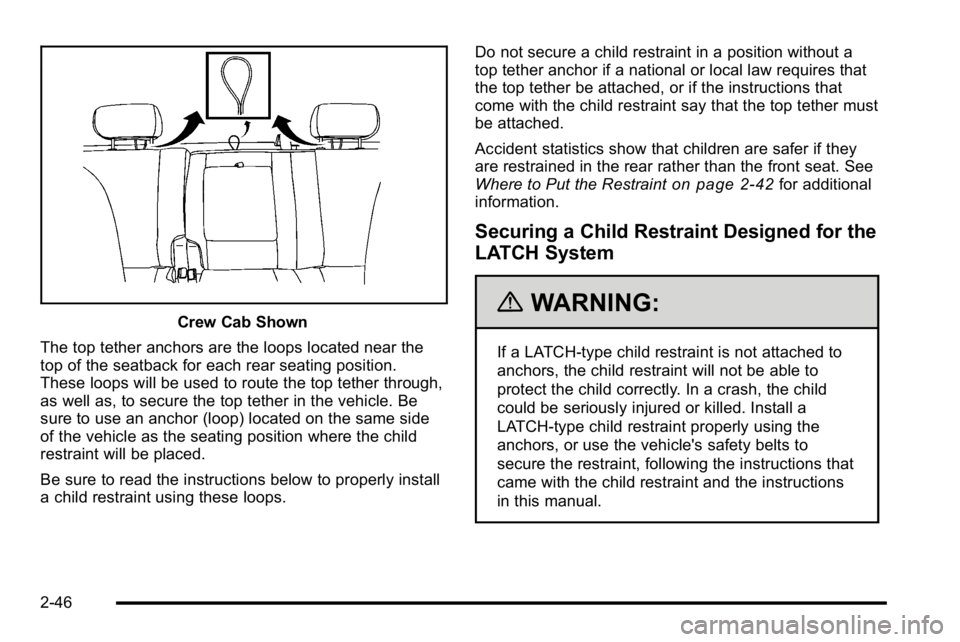
Crew Cab Shown
The top tether anchors are the loops located near the
top of the seatback for each rear seating position.
These loops will be used to route the top tether through,
as well as, to secure the top tether in the vehicle. Be
sure to use an anchor (loop) located on the same side
of the vehicle as the seating position where the child
restraint will be placed.
Be sure to read the instructions below to properly install
a child restraint using these loops. Do not secure a child restraint in a position without a
top tether anchor if a national or local law requires that
the top tether be attached, or if the instructions that
come with the child restraint say that the top tether must
be attached.
Accident statistics show that children are safer if they
are restrained in the rear rather than the front seat. See
Where to Put the Restraint
on page 2‑42for additional
information.
Securing a Child Restraint Designed for the
LATCH System
{WARNING:
If a LATCH-type child restraint is not attached to
anchors, the child restraint will not be able to
protect the child correctly. In a crash, the child
could be seriously injured or killed. Install a
LATCH-type child restraint properly using the
anchors, or use the vehicle's safety belts to
secure the restraint, following the instructions that
came with the child restraint and the instructions
in this manual.
2-46
Page 83 of 550
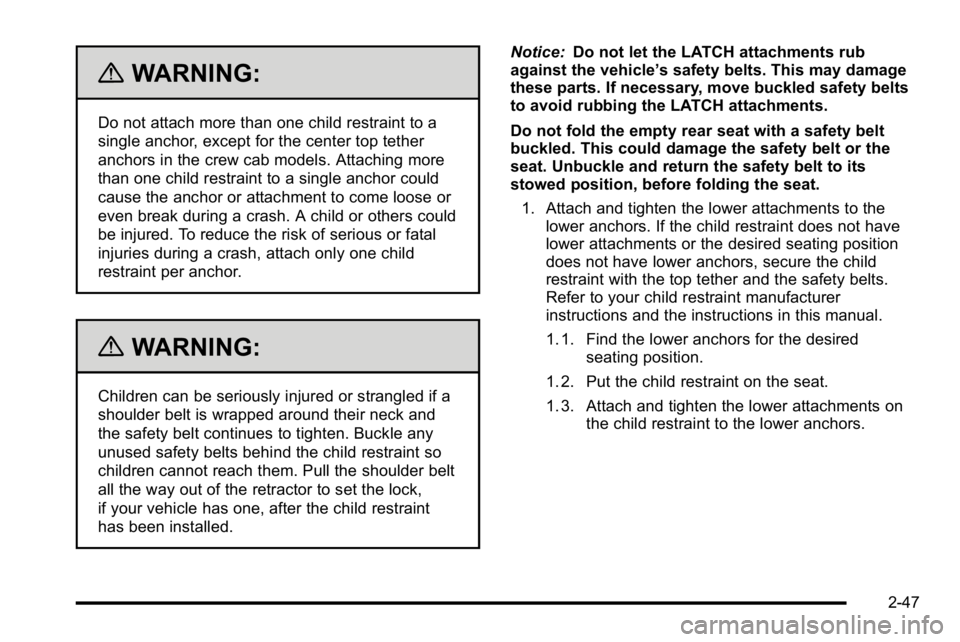
{WARNING:
Do not attach more than one child restraint to a
single anchor, except for the center top tether
anchors in the crew cab models. Attaching more
than one child restraint to a single anchor could
cause the anchor or attachment to come loose or
even break during a crash. A child or others could
be injured. To reduce the risk of serious or fatal
injuries during a crash, attach only one child
restraint per anchor.
{WARNING:
Children can be seriously injured or strangled if a
shoulder belt is wrapped around their neck and
the safety belt continues to tighten. Buckle any
unused safety belts behind the child restraint so
children cannot reach them. Pull the shoulder belt
all the way out of the retractor to set the lock,
if your vehicle has one, after the child restraint
has been installed.Notice:
Do not let the LATCH attachments rub
against the vehicle’ s safety belts. This may damage
these parts. If necessary, move buckled safety belts
to avoid rubbing the LATCH attachments.
Do not fold the empty rear seat with a safety belt
buckled. This could damage the safety belt or the
seat. Unbuckle and return the safety belt to its
stowed position, before folding the seat.
1. Attach and tighten the lower attachments to the lower anchors. If the child restraint does not have
lower attachments or the desired seating position
does not have lower anchors, secure the child
restraint with the top tether and the safety belts.
Refer to your child restraint manufacturer
instructions and the instructions in this manual.
1. 1. Find the lower anchors for the desired seating position.
1. 2. Put the child restraint on the seat.
1. 3. Attach and tighten the lower attachments on the child restraint to the lower anchors.
2-47
Page 84 of 550
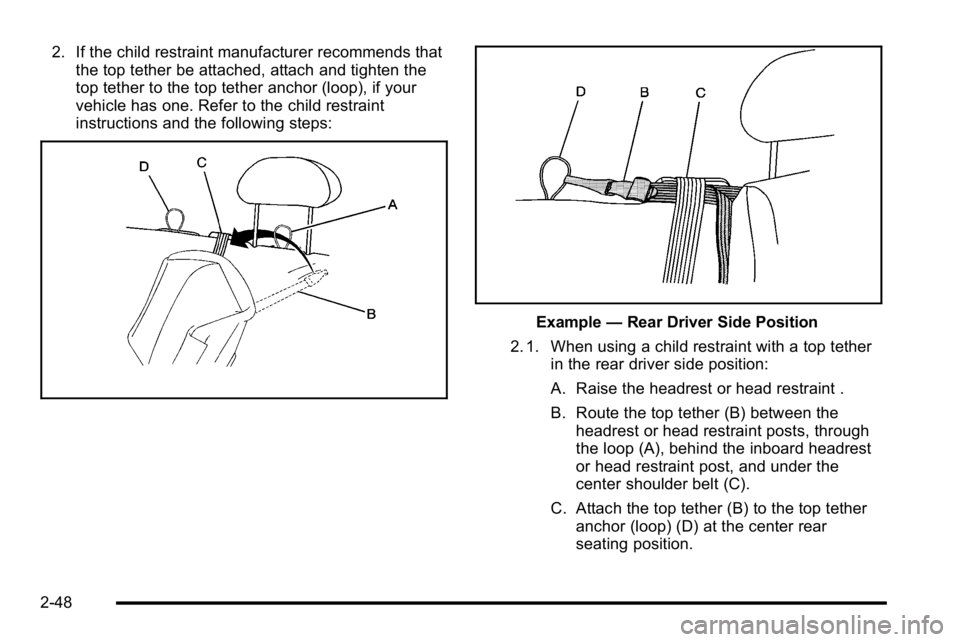
2. If the child restraint manufacturer recommends thatthe top tether be attached, attach and tighten the
top tether to the top tether anchor (loop), if your
vehicle has one. Refer to the child restraint
instructions and the following steps:
Example —Rear Driver Side Position
2. 1. When using a child restraint with a top tether in the rear driver side position:
A. Raise the headrest or head restraint .
B. Route the top tether (B) between theheadrest or head restraint posts, through
the loop (A), behind the inboard headrest
or head restraint post, and under the
center shoulder belt (C).
C. Attach the top tether (B) to the top tether anchor (loop) (D) at the center rear
seating position.
2-48
Page 85 of 550
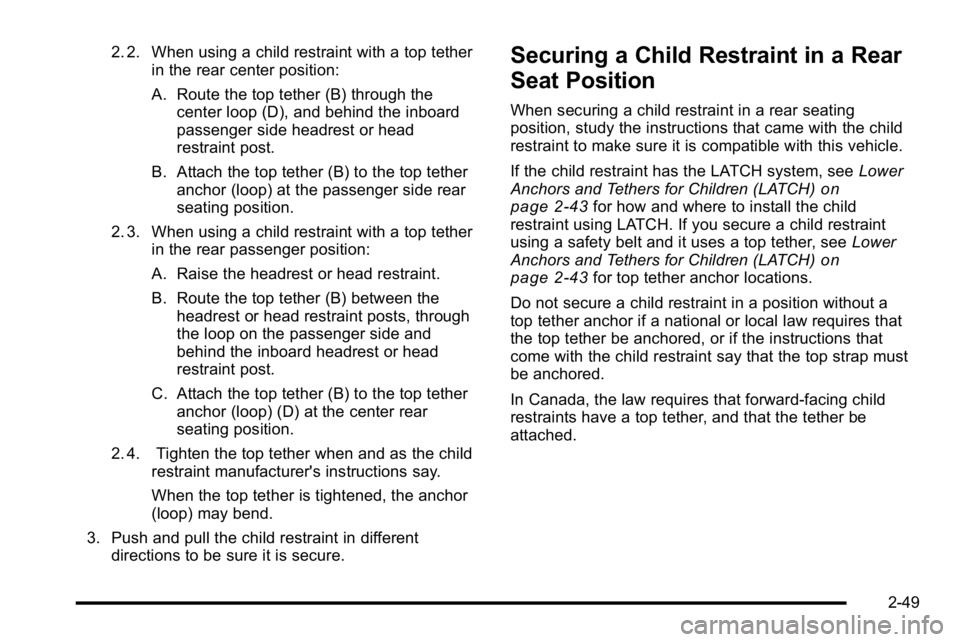
2. 2. When using a child restraint with a top tetherin the rear center position:
A. Route the top tether (B) through the
center loop (D), and behind the inboard
passenger side headrest or head
restraint post.
B. Attach the top tether (B) to the top tether anchor (loop) at the passenger side rear
seating position.
2. 3. When using a child restraint with a top tether in the rear passenger position:
A. Raise the headrest or head restraint.
B. Route the top tether (B) between theheadrest or head restraint posts, through
the loop on the passenger side and
behind the inboard headrest or head
restraint post.
C. Attach the top tether (B) to the top tether anchor (loop) (D) at the center rear
seating position.
2. 4. Tighten the top tether when and as the child restraint manufacturer's instructions say.
When the top tether is tightened, the anchor
(loop) may bend.
3. Push and pull the child restraint in different directions to be sure it is secure.Securing a Child Restraint in a Rear
Seat Position
When securing a child restraint in a rear seating
position, study the instructions that came with the child
restraint to make sure it is compatible with this vehicle.
If the child restraint has the LATCH system, see Lower
Anchors and Tethers for Children (LATCH)
on
page 2‑43for how and where to install the child
restraint using LATCH. If you secure a child restraint
using a safety belt and it uses a top tether, see Lower
Anchors and Tethers for Children (LATCH)
on
page 2‑43for top tether anchor locations.
Do not secure a child restraint in a position without a
top tether anchor if a national or local law requires that
the top tether be anchored, or if the instructions that
come with the child restraint say that the top strap must
be anchored.
In Canada, the law requires that forward-facing child
restraints have a top tether, and that the tether be
attached.
2-49